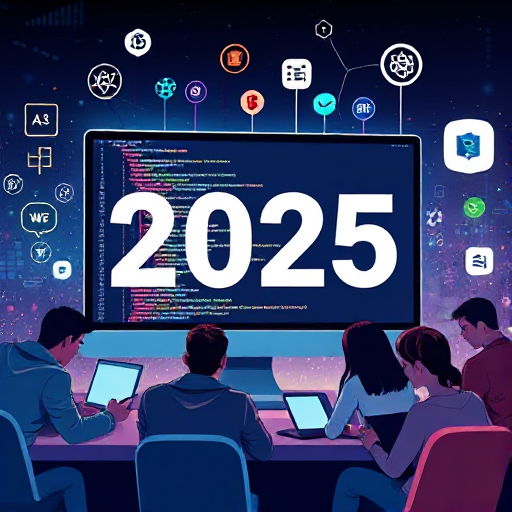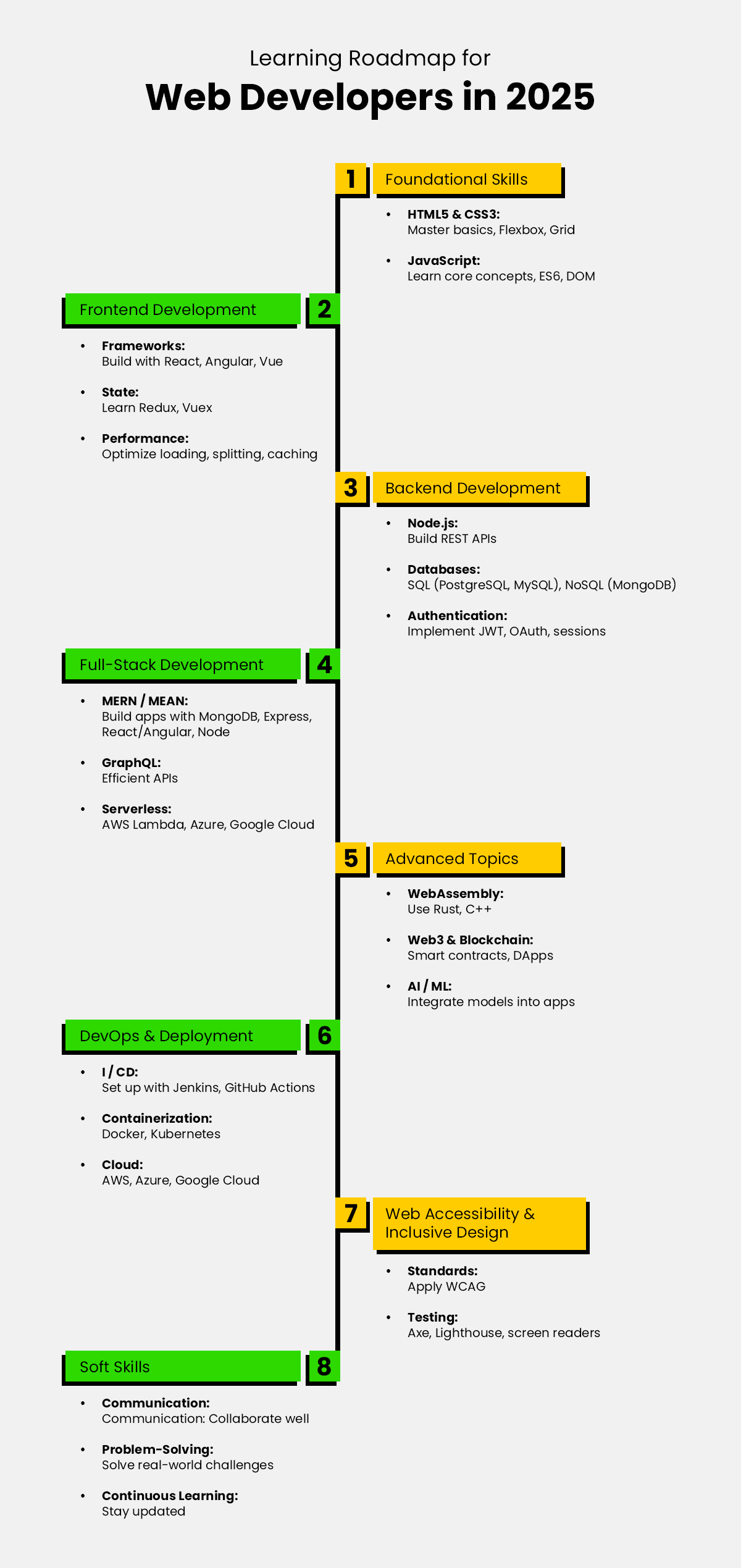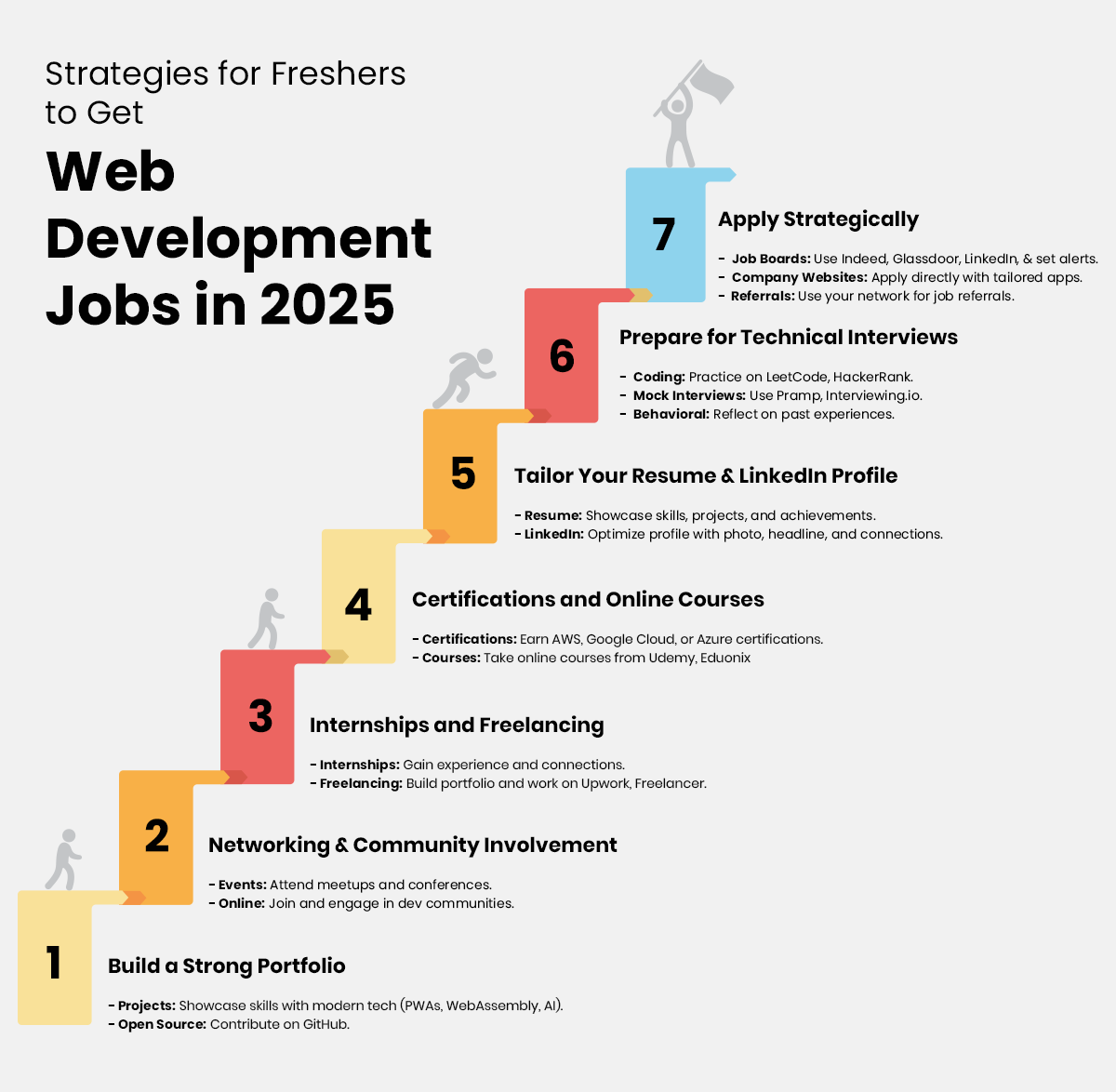As we step into 2025, the world of web development continues to evolve at a rapid pace. The technologies that were once considered cutting-edge are now mainstream, and new tools and frameworks are emerging to address the ever-growing demands of modern web applications. For aspiring web developers, staying ahead of the curve is crucial to securing a successful career in this dynamic field. In this blog post, we’ll explore the state of web development technologies in 2025, provide a detailed learning roadmap, and discuss strategies for freshers to land their first web development job.
The State of Web Development Technologies in 2025
1. JavaScript and Its Ecosystem
JavaScript remains the backbone of web development, and its ecosystem continues to expand. In 2025, frameworks like React, Angular, and Vue.js are still dominant, but newer frameworks like Svelte and SolidJS are gaining traction due to their performance benefits and simplicity. TypeScript, a superset of JavaScript, has become the de facto standard for large-scale applications, offering type safety and improved developer productivity.
2. Server-Side Technologies
Node.js continues to be a popular choice for server-side development, with Deno emerging as a strong contender due to its built-in TypeScript support and enhanced security features. Python, with frameworks like Django and Flask, remains a favorite for backend development, especially in data-intensive applications. Rust is also making waves in the backend space, offering memory safety and performance advantages.
3. WebAssembly (Wasm)
WebAssembly has matured significantly by 2025, enabling high-performance web applications that rival native apps. Developers are increasingly using Wasm to run computationally intensive tasks, such as video editing, gaming, and scientific simulations, directly in the browser. Languages like Rust, C++, and Go are commonly used to compile to Wasm.
4. Progressive Web Apps (PWAs)
PWAs have become the standard for building web applications that offer a native app-like experience. With features like offline support, push notifications, and fast loading times, PWAs are being adopted by major companies to enhance user engagement. Tools like Workbox and Lighthouse are essential for developing and optimizing PWAs.
5. Web3 and Decentralized Applications (dApps)
The rise of blockchain technology has led to the growth of Web3 and decentralized applications. Ethereum, Solana, and other blockchain platforms are being used to build dApps that offer transparency, security, and user control. Smart contract development, using languages like Solidity, is becoming a valuable skill in the web development landscape.
6. AI and Machine Learning Integration
AI and machine learning are increasingly being integrated into web applications to provide personalized experiences, automate tasks, and analyze data. Libraries like TensorFlow.js and Brain.js allow developers to implement AI features directly in the browser. AI-powered tools, such as GitHub Copilot, are also assisting developers in writing code more efficiently.
7. Low-Code and No-Code Platforms
Low-code and no-code platforms have gained popularity, enabling non-developers to build web applications with minimal coding. However, professional developers are still needed to customize and extend these platforms. Tools like Webflow, Bubble, and Retool are leading the charge in this space.
8. Web Accessibility and Inclusive Design
Web accessibility has become a top priority, with stricter regulations and a growing awareness of the importance of inclusive design. Developers are expected to have a strong understanding of accessibility standards (WCAG) and tools like screen readers, ARIA roles, and automated accessibility testing tools.
9. DevOps and CI/CD
DevOps practices and continuous integration/continuous deployment (CI/CD) pipelines are essential for modern web development. Tools like Docker, Kubernetes, Jenkins, and GitHub Actions are widely used to automate the deployment process, ensuring faster and more reliable releases.
10. Edge Computing
Edge computing is transforming how web applications are delivered, reducing latency and improving performance by processing data closer to the user. Technologies like Cloudflare Workers and AWS Lambda@Edge are enabling developers to build edge-native applications.
Learning Roadmap for Web Developers in 2025
To become a successful web developer in 2025, you need to follow a structured learning path that covers both foundational and advanced topics. Here’s a detailed roadmap:
1. Foundational Skills
- HTML/CSS: Master the basics of HTML5 and CSS3, including responsive design, Flexbox, and Grid.
- JavaScript: Learn core JavaScript concepts, ES6+ features, and DOM manipulation.
- Version Control: Get comfortable with Git and GitHub for version control and collaboration.
2. Frontend Development
- JavaScript Frameworks: Choose a framework (React, Angular, or Vue.js) and build projects to gain hands-on experience.
- State Management: Learn state management libraries like Redux (for React) or Vuex (for Vue.js).
- Web Performance: Understand techniques for optimizing web performance, such as lazy loading, code splitting, and caching.
3. Backend Development
- Node.js: Learn the basics of Node.js and build RESTful APIs using Express.js.
- Databases: Gain proficiency in both SQL (PostgreSQL, MySQL) and NoSQL (MongoDB) databases.
- Authentication: Implement authentication and authorization using JWT, OAuth, or session-based authentication.
4. Full-Stack Development
- MERN/MEAN Stack: Build full-stack applications using the MERN (MongoDB, Express, React, Node.js) or MEAN (MongoDB, Express, Angular, Node.js) stack.
- GraphQL: Learn GraphQL for building efficient and flexible APIs.
- Serverless Architecture: Explore serverless computing using AWS Lambda, Azure Functions, or Google Cloud Functions.
5. Advanced Topics
- WebAssembly: Experiment with WebAssembly by compiling code from languages like Rust or C++.
- Web3 and Blockchain: Dive into blockchain development, smart contracts, and building decentralized applications.
- AI/ML Integration: Explore AI/ML libraries and integrate machine learning models into your web applications.
6. DevOps and Deployment
- CI/CD Pipelines: Set up CI/CD pipelines using tools like Jenkins, GitHub Actions, or GitLab CI.
- Containerization: Learn Docker and Kubernetes for containerization and orchestration.
- Cloud Platforms: Gain experience with cloud platforms like AWS, Azure, or Google Cloud.
7. Web Accessibility and Inclusive Design
- Accessibility Standards: Study WCAG guidelines and implement accessible web designs.
- Testing Tools: Use tools like Axe, Lighthouse, and screen readers to test and improve accessibility.
8. Soft Skills
- Communication: Develop strong communication skills for collaborating with teams and stakeholders.
- Problem-Solving: Hone your problem-solving skills by working on real-world projects and challenges.
- Continuous Learning: Stay updated with the latest trends and technologies in web development.
Strategies for Freshers to Get Web Development Jobs in 2025
1. Build a Strong Portfolio
- Personal Projects: Create a portfolio of personal projects that showcase your skills in frontend, backend, and full-stack development. Include projects that demonstrate your ability to work with modern technologies like PWAs, WebAssembly, or AI integration.
- Open Source Contributions: Contribute to open-source projects on GitHub. This not only helps you gain experience but also demonstrates your ability to collaborate with other developers.
2. Networking and Community Involvement
- Attend Meetups and Conferences: Participate in web development meetups, hackathons, and conferences to network with industry professionals and learn about the latest trends.
- Online Communities: Join online communities like Stack Overflow, Reddit, or Discord groups related to web development. Engage in discussions, ask questions, and share your knowledge.
3. Internships and Freelancing
- Internships: Apply for internships to gain real-world experience and build connections in the industry. Many companies offer internships that can lead to full-time positions.
- Freelancing: Take on freelance projects to build your portfolio and gain experience working with clients. Platforms like Upwork, Freelancer, and Toptal can help you find freelance opportunities.
4. Certifications and Online Courses
- Certifications: Obtain certifications in relevant technologies, such as AWS Certified Developer, Google Cloud Professional, or Microsoft Certified: Azure Developer. Certifications can help you stand out to potential employers.
- Online Courses: Enroll in online courses from different platforms like Udemy or Eduonix to learn new skills and stay updated with the latest technologies.
5. Tailor Your Resume and LinkedIn Profile
- Resume: Customize your resume to highlight your relevant skills, projects, and experience. Use action verbs and quantify your achievements (e.g., “Improved website performance by 30% using lazy loading and code splitting”).
- LinkedIn Profile: Optimize your LinkedIn profile with a professional photo, a compelling headline, and a detailed summary of your skills and experience. Connect with industry professionals and join relevant groups.
6. Prepare for Technical Interviews
- Coding Challenges: Practice coding challenges on platforms like LeetCode, HackerRank, or CodeSignal. Focus on algorithms, data structures, and problem-solving skills.
- Mock Interviews: Participate in mock interviews to simulate real interview scenarios. Platforms like Pramp and Interviewing.io offer mock interviews with experienced developers.
- Behavioral Questions: Prepare for behavioral questions by reflecting on your past experiences and how you’ve handled challenges, worked in teams, and demonstrated leadership.
7. Apply Strategically
- Job Boards: Use job boards like Indeed, Glassdoor, and LinkedIn to find web development job openings. Set up job alerts to stay informed about new opportunities.
- Company Websites: Research companies you’re interested in and apply directly through their career pages. Tailor your application to each company and role.
- Referrals: Leverage your network to get referrals for job openings. Referrals can significantly increase your chances of getting an interview.
Conclusion
The web development landscape in 2025 is both exciting and challenging, with new technologies and trends shaping the future of the industry. By following a structured learning roadmap, building a strong portfolio, and strategically applying for jobs, freshers can position themselves for success in this competitive field. Remember, continuous learning and adaptability are key to thriving as a web developer in 2025 and beyond. Good luck on your journey to becoming a successful web developer!






